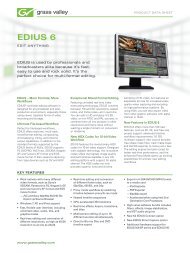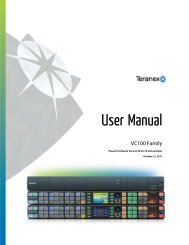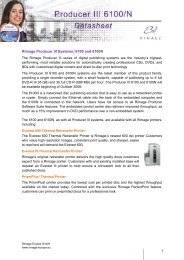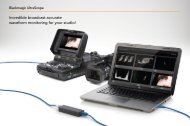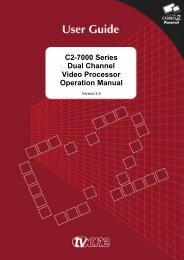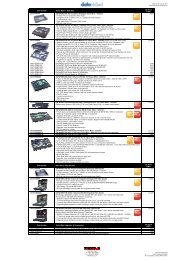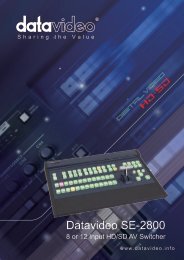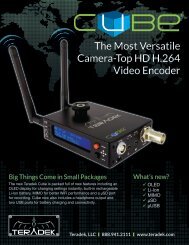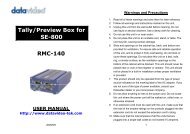ATEM Switchers Manual - Holdan.eu
ATEM Switchers Manual - Holdan.eu
ATEM Switchers Manual - Holdan.eu
Create successful ePaper yourself
Turn your PDF publications into a flip-book with our unique Google optimized e-Paper software.
99<br />
Operating Your <strong>ATEM</strong> Switcher<br />
If you’re in a hurry to get your graphics on air, then you can select to automatically copy this graphic to either<br />
media player 1 or media player 2 after download. This lets you get images to air fast! If you don't want to<br />
interfere with the media player graphic sources, simply select not to copy the media players to this graphic.<br />
Pre Multiply Alpha should almost always be enabled and requires that you also switch on the Pre Multiplied<br />
Key setting in <strong>ATEM</strong> Software Control or on the optional <strong>ATEM</strong> Broadcast Panel. Premultiplying mixes the<br />
graphic color with its alpha channel when exporting to ensure your graphic has smooth edges which blend<br />
in to the video.<br />
Auxiliary Outputs Control Menus on Mac OS X<br />
Auxiliary Outputs Control Menus on Windows<br />
List of Auxiliary Output Sources<br />
Using Auxiliary Outputs<br />
The <strong>ATEM</strong> 1 M/E and 2 M/E production switchers have auxiliary outputs which are spare SDI outputs that<br />
can have various inputs and internal sources routed to them. They are very similar to router outputs, and all<br />
video inputs, color generators, media players, program, preview and even color bars can be output.<br />
If you want an extra program output, then aux outputs are perfect to use, or if you need a clean feed before<br />
one or both of the down stream keyers, then you can even select these to the aux outputs. This would<br />
give you a program feed without a logo or bug, so you can capture this as a broadcast master for later<br />
transmission.<br />
Aux outputs are extremely powerful, and can be routed on the software control panel, as well as the<br />
hardware based broadcast panel. The aux output menus are available in the menu bar at the top of the<br />
software control panel regardless of the tab currently selected so they are always available.<br />
The switcher will always perform a clean switch when an auxiliary output changes sources so this means you<br />
can use the switcher to cut between sources on the auxiliary output cleanly and without glitches.<br />
Routing Auxiliary Outputs<br />
On the <strong>ATEM</strong> software control each aux output has a menu for selecting the source to output on the aux<br />
video output. Simply select the menu, and then scroll the list for the source you want to output. When<br />
selected, the output on the selected aux will change immediately. You can see the current source with a tick<br />
in the menu item.<br />
On the <strong>ATEM</strong> broadcast panel the aux outputs are set from the aux menu in the system control.<br />
Once the desired aux output is selected, you use the select bus to route the source to the aux<br />
output. Because the broadcast panel uses the select bus, it's very fast to control aux outputs from the<br />
broadcast panel.<br />
Auxiliary outputs are assignable on the <strong>ATEM</strong> 2 M/E Broadcast Panel using the Destination bus. Once the<br />
desired Aux is selected in the Destination bus, you can use the Select bus to assign an input to it.<br />
Whatever video and audio is output on Aux 1 is also output on the USB 3.0 port.




